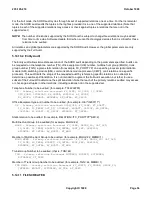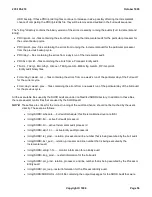
A stable or transient clear backs out all RCs and CORCs entered since the last ODD backup. This is because
system initialization restores the memory version of the ODD with the disk version created by the most recent ODD
backup. The ODD recovery consists of reapplying the backed-out RCs and CORCs. Records of the RCs and
CORCs are logged in disk files during the updating process. The ODD recovery provides all features needed by
maintenance personnel to recover the ODD.
The
EXC:ODDRCVY;
input message is usually generated automatically after a system initialization is completed.
The output message generated is prefixed with an ``A'' to indicate that the ODD recovery was automatically started.
Manual recovery is needed after all craft-initiated system initializations. Manual recovery is also needed after
automatic initializations when the system integrity monitor determines that the ODD recovery may be faulty. When
manual intervention is needed, the EXC ODDRCVY NOT STARTED alarm message is dumped to indicate that the
automatic recovery was not started and that a manual ODD recovery is needed. All recent change activity is blocked
until the command has been completed.
One of the following
EXC:ODDRCVY;
message sections may be used to manually recover the ODD:
RCLOG for recovery of all regular recent changes
CORCLOG for recovery of all customer-originated recent changes
ALL for recovery of all regular and customer-originated recent changes.
If a manual recovery is needed and the
OP:LOGSTAT;
message is run, the OP LOGSTAT output message
displays a reminder that the ODD recovery has not been performed since the system initialization occurred. The
ODD recovery procedures can be found in 235-105-250,
System Recovery
.
5.14 AUTOMATED SODD AUDIT
5.14.1 FEATURE DEFINITION
The Automated SODD Audit feature allows the Operating Company to maintain a clean data base. This new audit is
automatically generated from the PRL5 data base population rule source files, ensuring completeness and
accuracy. The PRL5 is a new technology that is a declarative language which allows implementation and
optimization of Full and Incremental validation.
There are three modes of audit execution.
(1)
Full Audit: The Full Audit validates the ODD with respect to a large set of population rules. It executes in an
infinite loop, starting and suspending itself according to a schedule established by the Operating Company
personnel. A single cycle through the full audit may take several weeks to complete. Each time this cyclic
audit resumes execution, it picks up where the previous execution suspended.
(2)
Incremental Audit: The Incremental audit automatically executes after each successful backup of office
dependent data (
BKUP:ODD
). It validates data base transactions [both recent changes (RCs) and
customer-originated recent changes (CORCs)] since the previous
BKUP:ODD
. The audit executes only after
the whole backup is completed.
(3)
Entity Audit: The Operating Company personnel can request immediate execution of the audit. Such requests
would limit the scope of an audit to the following entities:
Telephone Number (TN)
Office Equipment Number (OE)
235-105-210
October 1999
Copyright © 1999
Page 42
Summary of Contents for 5ESS-2000
Page 96: ...235 105 210 October 1999 Copyright 1999 Page 2 ...
Page 184: ...235 105 210 October 1999 Copyright 1999 Page 3 ...
Page 300: ...13 STOP YOU HAVE COMPLETED THIS PROCEDURE 235 105 210 October 1999 Copyright 1999 Page 55 ...
Page 339: ...7 STOP YOU HAVE COMPLETED THIS PROCEDURE 235 105 210 October 1999 Copyright 1999 Page 13 ...
Page 342: ...235 105 210 October 1999 Copyright 1999 Page 2 ...
Page 359: ...235 105 210 October 1999 Copyright 1999 Page 5 ...
Page 609: ...2 STOP YOU HAVE COMPLETED THIS PROCEDURE 235 105 210 October 1999 Copyright 1999 Page 12 ...
Page 676: ...235 105 210 October 1999 Copyright 1999 Page 9 ...
Page 792: ...3 STOP YOU HAVE COMPLETED THIS PROCEDURE 235 105 210 October 1999 Copyright 1999 Page 9 ...
Page 799: ...Figure 11 36 3 1 Cleaning Points 235 105 210 October 1999 Copyright 1999 Page 7 ...
Page 801: ...235 105 210 October 1999 Copyright 1999 Page 9 ...
Page 839: ...2 STOP YOU HAVE COMPLETED THIS PROCEDURE 235 105 210 October 1999 Copyright 1999 Page 16 ...
Page 999: ...2 STOP YOU HAVE COMPLETED THIS PROCEDURE 235 105 210 October 1999 Copyright 1999 Page 13 ...
Page 1008: ...Figure 11 55 1 CTSNS DIP Switch Settings 235 105 210 October 1999 Copyright 1999 Page 2 ...
Page 1011: ...235 105 210 October 1999 Copyright 1999 Page 5 ...
Page 1053: ...235 105 210 October 1999 Copyright 1999 Page 15 ...
Page 1289: ...Figure 15 17 2 AMATPS Data Link 235 105 210 October 1999 Copyright 1999 Page 2 ...
Page 1292: ...235 105 210 October 1999 Copyright 1999 Page 5 ...
Page 1303: ...9 STOP YOU HAVE COMPLETED THIS PROCEDURE 235 105 210 October 1999 Copyright 1999 Page 2 ...
Page 1360: ...Figure 15 47 2 Typical SCANS III Link Diagram 235 105 210 October 1999 Copyright 1999 Page 2 ...
Page 1372: ...235 105 210 October 1999 Copyright 1999 Page 2 ...
Page 1374: ...235 105 210 October 1999 Copyright 1999 Page 4 ...
Page 1421: ...Table 1 1 O M Checklist 235 105 210 October 1999 Copyright 1999 Page 3 ...
















































